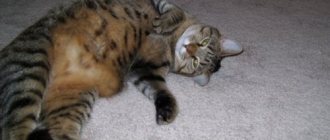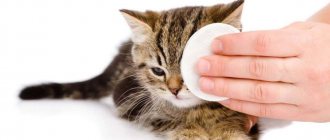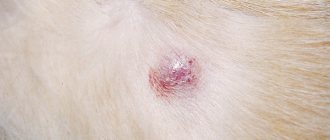If an abscess forms under the periosteum, the cat develops flux. The pathology is accompanied by pain, swelling and bleeding of the gums, and the appearance of an unpleasant odor. At the first symptoms, the owner should contact the animal with a veterinarian, who will conduct a diagnosis, perform surgery, prescribe medications and recommend treatment at home.
Veterinarian-dentist G. Dubravnaya recommends that owners bring their pets for a preventive examination once every 6 months, especially if the cat is older than 3 years.
Symptoms
What are the symptoms? They are quite typical, since any person who has suffered from toothache at least once in their life has felt something similar:
- The first sign is often loose teeth and the appearance of blood on the toys the cat plays with.
- The animal's mouth smells very bad, which indicates that putrefactive processes have begun.
- The cat begins to feel ill, is reluctant to eat, and often refuses food altogether (during the period of exacerbation of toothache).
- If you look closely, you can see areas of swelling, redness, and brewing abscesses in the oral cavity. This is the most characteristic sign.
- Due to severe pain (with the development of pulpitis), the animal does not sleep well, sometimes, for no apparent reason, it begins to “growl”, meow hoarsely and forcefully.
- Sometimes your pet's cheek becomes swollen (pictured). But, unlike “human” flux, this happens infrequently.
Diagnosis of the disease is quite simple, in many cases everything is limited to an external examination. If the veterinarian suspects that the process has spread to the periosteum, an x-ray and/or ultrasound examination is done, through which cavities and cavities can be detected in the bone tissue itself.
An abscess is an abscess that forms inside the cat’s skin and requires treatment. The disease occurs due to infection. The skin rises, swelling is visible (sometimes large). Purulent contents accumulate in the cavity between the skin and muscles. An abscess in cats (pictured) can occur in any part of the body if it is traumatic. Possible (often happens) in the cheek area, under the eye, when caused by inflammatory disease of the teeth. The classification of abscesses in a cat depends on the place of their occurrence and the cause of their appearance. There are dental abscesses (tissue around the root of the tooth becomes inflamed) and combat abscesses (consequences of injuries in cat fights) in cats. According to the type of disease, both types are divided into:
- Superficial - the abscess is small, close to the surface, usually opens on its own. There is not a lot of pus, it is not complicated, it heals easily.
- Deep. A bite from a fang creates a small but inward wound. The infection penetrates deeper and the disease becomes more severe. A lump can be felt in the damaged area; the skin does not necessarily look changed.
- Acute – rapidly occurring, so-called “hot” abscesses. They often open up on their own.
- Cold. The title does not reflect the seriousness of the process, although it is a chronicle. Usually - a kind of deep, can be repeated (relapse) over a long period (years).
- Benign. The process proceeds with the formation of thick yellowish-white masses. There is no pungent odor, the prognosis is favorable.
- Malignant. The name is informative: the immune system is weak, pathogenic organisms take over, the infection spreads (spill) through adjacent tissues. This type of abscess in the mouth produces a strong, unpleasant odor when the cat breathes.
Treatment of flux in a cat
Flux is an inflammatory process that occurs near the root of a tooth or inside it and leads to the formation of a pathological cavity in the lesion with the accumulation of pus, that is, with the formation of an abscess. The cause of abscess formation is the proliferation in the area of the pathological focus of bacteria that have penetrated into the tissue through damage to the gums or tooth. The consequences of flux formation are very unpleasant. The cat experiences severe pain, its appetite decreases, and depression may appear. In some cases, an abscess opens in the gum area or other parts of the oral cavity and even on the outer surface of the muzzle as a result of the formation of a fistula. The roots of the tooth are destroyed and, accordingly, it falls out or it becomes necessary to remove it. The jaw is deformed. The infection often spreads to other parts of the oral cavity and even distant organs (including the heart, etc.). This determines the need for regular examination of the oral cavity of cats, including the absence of signs of gumboil formation, and if any are detected, treatment.
If the inflammatory process affects only soft tissues (gum), then in some cases it can be stopped with local treatments. For this purpose, use a solution of brilliant blue, iodinol (not to be confused with an alcohol solution of iodine, which can cause severe burns to the gums), alternating ointments with antibiotics (fluoroquinolone, tetetracycline, metronidazole, etc.) and solcoseryl. Regular irrigation of the oral cavity and flux-affected tissues with decoctions of chamomile, sage, and oak bark will not hurt.
However, such treatments are difficult for many cats to carry out, and to achieve a positive effect this should be done many times a day. Therefore, treatment is most often completed by a veterinarian specializing in dentistry. In mild cases, it is sufficient to open the abscess, remove necrotic tissue and pus, followed by antiseptic treatment of the abscess cavity, fistula, gum pocket, etc. But most often, they turn to a veterinary specialist when the disease is already so advanced that there is nothing left to do but remove tooth. If by this time a deformation of the jaw has occurred, then they resort to rather complex surgical procedures to restore the structure of the jaw, which is important not so much because of the appearance of the animal, but because of the need to create conditions under which it could normally accept and chew food. In addition, due to the fragility of the skeleton in cats, such deformation can cause a jaw fracture.
In the postoperative period, a course of antimicrobial therapy is administered to prevent the spread of infection.
Veterinary services
Causes of abscess in cats and cats
A scratch, a wound, a bite from another “roof neighbor” - any damage to the skin opens the door to infection. The smaller the injury, the greater the cat's risk of developing an abscess. This is explained simply. When the wound is open, the microbes that have entered it can come out along with blood or pus, and the animal recovers. A small surface of damage, especially a pinpoint one (like an injection), heals very quickly and is delayed. Foreign microorganisms that get inside remain alive. If the cat “fought” with another pet, was bitten or scratched, then the likelihood of infection with the subsequent occurrence of a purulent abscess is high. There could well be pathogenic microbes on the enemy’s claws or in his saliva. The problem is common, although there are not many causes of an abscess:
- The immune system comes into play; phagocytes and leukocytes flock to the site of invasion of pathogenic flora. Purulent contents form, but there is no way out (outflow). The site of this battle of microorganisms swells, swells, and a purulent abscess develops.
- An inflammatory process caused by dental disease. This happens from injury to the tooth by excessively hard food (for example, bone); age is also not the last factor.
- Secondary infection during treatment can also be the cause of the disease. Carrying out a medical intervention that violates the skin (injections, opening of abscesses) with non-compliance with sterility. An abscess in a cat can even occur at the injection site. Carry out all manipulations with a sterile instrument; animals are not insured against infection.
Symptoms and course of abscess in cats
A small wound under the fur is difficult to notice. It tightens quickly, almost no traces are visible. Therefore, the first sign of malaise is often the lethargy of the animal. If the problem in the mouth is related to the teeth, then the cat stops eating or tries to chew on one side, sparing the other. Sometimes it spits out food and rubs its cheek on the litter or ground.
The cat is in pain, she is patient, she does not cry, so it is worth looking closely at her behavior. An abscess in a cat (especially in the mouth) is not only painful, but also dangerous for complications, including general blood poisoning.
Patients are also susceptible to feline AIDS (immunodeficiency); the risk of contracting it remains after recovery.
Missing the first stage will lead to an intensification of the disease process. Once a tumor appears, it can no longer be overlooked.
Without treatment, the abscess continues to worsen, its development pattern looks like this:
- introduction of infection through the site of injury (this is not yet noticeable);
- slight swelling, sometimes redness of the skin;
- the area becomes hot to the touch (local increase in temperature);
- soreness (the cat moves away and does not allow you to palpate);
- intense redness of a round shape;
- the swelling increases and is clearly visible;
- the contents of the affected cavity are visible through the skin;
- If it does not open on its own or forcibly, the purulent contents of the abscess spill into other tissues.
Cat Seizure
These are UHF, hyperthermic baths and further wrapping, paraffin applications.
If the process becomes chronic, acutely irritating ointments are prescribed locally. The growths of fibrous and bone structure are removed surgically. If they do not interfere with the animal and do not disrupt the motor function of the limb, they are not touched.
After treatment, the animal is provided with care and control of intoxication, if any, by transfusion of solutions, blood, and antibacterial drugs.
Dogs, Cats
Treatment of a purulent abscess in a cat at home
Having established a diagnosis based on the listed symptoms, the animal must be shown to a doctor. A cat having an abscess in the mouth or on the body is a common occurrence. The veterinarian will easily diagnose and choose treatment tactics. Often the abscess has to be cut and opened to drain the contents. The clinic can perform this operation under general or local anesthesia, depending on the stage of the process and the condition of the furry patient. Hairless cats are less likely to develop abscesses - this is not a paradox, but a result of living conditions. They usually don’t walk on rooftops and don’t have to fight with their relatives. And the owners take care of their teeth and know the characteristics of the breed.
In most cases, antibiotics are prescribed; sulfa drugs help heal and eliminate unpleasant symptoms. The antibiotic is given for at least five days, often seven. Treatment cannot be interrupted, even if the mustachioed patient already looks healthy. If you stop taking it earlier, microbial resistance to this drug will develop. Then next time it will be useless.
No two situations are the same; you and your pet may be far from the cat doctor. And help is necessary. An abscess in a cat is a serious condition; treat it. Have patience, courage, draw up an algorithm of actions. Be your pet's savior yourself. Circumstances will “ask” you to become a surgeon for a while.
How to treat a cat's abscess yourself at home? Let's look at this step by step.
- Determine the stage of the disease. The initial stage is treated with heating - warm compresses and a heating pad will accelerate the maturation of the abscess. If the cat is very depressed due to pain, then you can give it an injection of novocaine, even a circumferential blockade (several injections of novocaine) to relieve pain. But keep in mind that if your cat has an elevated temperature and/or a significant tumor has formed in the sore spot, heat is contraindicated.
- An advanced disease requires surgical intervention; the accumulated masses need a way out. Prepare a sterile needle if the accumulation of exudate (abscess contents) is small and the puncture will be sufficient to drain this mass. If a cut is necessary, a razor blade sterilized in alcohol or hydrogen peroxide will do. There is a scalpel - even better.
- Wear sterile gloves. You will also need gauze (preferably ironed or sterile) wipes and hydrogen peroxide. You can use a solution of potassium permanganate, alcohol. Antibiotics will also be needed (solutions or ointments).
- It's good if you have help. He will hold the cat's paws during the procedure. It is not easy to make cuts or punctures on the head, but if necessary, you will have to. A purulent abscess that happened to a cat is no joke. If there is no one to help, then think about how best to keep your pet.
- First - pain relief. Novocaine, lidocaine - choose from the available means. A prudent animal owner has a first aid kit for them in case of emergency. Two or three injections around the abscess will help the cat undergo the operation more easily. Wait about ten minutes, the medicine will begin to work.
- Now it's up to you to act. Don't be afraid - this is a good thing. Now the cat is definitely not grateful to you, bear with both of you, you are saving the life of a little friend. How best to restrain a cat depends on the location of the tumor.
- If an abscess occurs on the cat’s neck, then after treatment it is advisable to put a special collar on the victim. It is made in the form of a cone, put on with the wide end forward. This will protect against subsequent scratching of the cut or puncture.
- Treatment of an abscess after freeing the cat’s cavity from exudate at home is no longer difficult. Cleaning the incision with antibiotics and dressings.
- Monitor the wound; it should not heal until the purulent contents cease to separate. The bandage is applied loosely, as air circulation is needed. Keep an eye on this; if it fits too tightly, it will disrupt the outflow and increase inflammation.
With normal healing, treatment for an abscess in cats lasts one week or a maximum of two weeks (when the incision is large).
Treatment of flux in a cat at home
Abscessation of tissues near or inside the root of the tooth, which is popularly called gumboil, not only causes discomfort in cats due to a pain reaction, but also makes it difficult to eat food, and if the inflammatory process progresses, fistulas occur, tooth roots are destroyed, the jaw is deformed, and infection causes the disease. bacteria spreads to other teeth and organs, including distant ones (heart, kidneys, etc.).
You can try to stop the development of inflammation at home, but, firstly, it is not easy to treat cats (especially if they have a toothache!), and, secondly, in many cases it is impossible to do without the qualified help of a veterinary dentist.
What can help if only soft gum tissue is involved in the inflammatory process? The source of inflammation is treated several times a day with a solution of brilliant blue, iodine, irrigated with a solution of chlorophyllipt (1 tablespoon per glass of boiled water) or strong decoctions of anti-inflammatory herbal mixtures (for example, chamomile, sage, St. John's wort, calendula, oak bark), lubricated with onion juice and ointments with antibiotics (fluoroquinolone, teteracycline, metronidazole, etc.).
If there is no effect from the above remedies, you should contact a specialist who will determine the nature of the pathological process and how to eliminate it (most often it is necessary to remove the affected tooth).
Add a comment Cancel reply
Veterinary services
Permits of the veterinary clinic:
The video has been deleted.
certificate of state registration of a legal entity, series 53 No. 001261507; certificate of registration with the tax authority, series 53 No. 001261508; sanitary and epidemiological conclusion No. 78.01.03.915.P.004729.08.06; Permission from the Veterinary Department to carry out active immunization of animals No. 238.
Preventing abscess in cats
- It is important to remember that the main risk factor is cat fights. How to protect your ward from them? Animal aggression is greatly reduced by castration or sterilization. This will not harm their health and will make their character calmer. There will be much fewer maintenance problems.
- The most reliable way to protect against injury is to live at home, without walking. At the same time, worries about your pet will disappear; at home, he also does not risk getting any contagious disease.
- If you discover damage to your cat’s skin, do not allow crusts to form and wounds to heal. Carefully remove these crusts by soaking them with a gauze swab soaked in a disinfectant solution (or a bandage folded into a square). If a pathogenic process is going on inside the tissues, then the contents will be able to come out while the wound is open. Knowing that your pet is a fighter, and seeing the consequences of the next fight, examine him very carefully.
An abscess from a bite or scratch can occur in a cat on any area of the body: neck, paws, tail. More often this happens in those places where the fighters hit with their paws, or where they bite. An abscess that has formed in a cat’s eye area is easy to notice. But only when it is already swollen and formed. If you find a wound in time, treat it and do not let it heal immediately. This way you can prevent the problem. It is necessary to find all the damage; sometimes furry beauties have to be cut off to do this.
Preventing the occurrence of an abscess in a sick cat after an injection is extremely simple. Use exclusively sterile instruments (as for humans), with all precautions, only then the risk is minimal. Never use the same syringe for different animals when you are treating or vaccinating them. Check the expiration date of the syringe and the integrity of the packaging.
It is always easier to prevent any surprise than to eliminate it later. Pay attention to preventive measures, and your student will be protected to the maximum.
Your care will pay off - your pets will live nearby for many years, full of pleasant events, bringing joyful emotions.
Aseptic periostitis in animals
Aseptic periostitis occurs after closed bone injuries, especially in poorly protected areas.
Therefore, most often these are the fetlock, metatarsal, metacarpal, coronoid, carpal, tarsal bones, as well as the bones of the skull, of which the most vulnerable are the dorsum of the nose, as well as the lower jaw.
Aseptic forms of the disease develop after ligaments or tendons are torn off from the periosteum, as well as in improperly equipped livestock buildings, when the animal is forced to bend the joints of the limbs, injuring the metacarpal bones on the feeder.
Periostitis is an inflammation of the periosteum. They have different origins:
- Post-traumatic. Occur after injuries (tendon rupture, wounds, bruises, bone fractures);
- Inflammatory in nature, when the infection spreads by contact from nearby organs and other anatomical structures;
- Severe general diseases and exposure to external toxins lead to the development of toxic periostitis;
- Of a specific nature (for example, tuberculosis).
How does the disease develop?
After injury, blood vessels rupture. The bloodstream of the periosteum itself is also damaged, and serous and serous-fibrous exudate is exuded. As a result, we see a typical inflammatory reaction. The process starts with the inner layers and extends throughout. Resorption of the lesion will occur if the damaging factor is eliminated in time. If damage to the periosteum continues, more vessels rupture, a significant amount of fibrinogen effusions, and cellular elements leak into the surrounding tissues and periosteum. These elements permeate the fibrous layer of the periosteum, its cells intensively grow into the affected areas of tissue. So aseptic periostitis develops into fibrous, and then into ossifying.
Clinical signs
All inflammatory processes of the periosteum are accompanied by the appearance of swelling. It is poorly limited; when palpated, a sharp pain occurs, since many nerve fibers pass through these places. Locally, an increase in temperature can be noted. An animal limps if its limbs are affected (weight-bearing lameness). There is usually no general response to this type of inflammation other than a slight increase in temperature in horses.
Treatment methods
The pet is treated according to the general rules of aseptic inflammation. First of all, it is necessary to ensure rest for 1-2 weeks. Aseptic inflammation lasts much longer than bruises, sometimes more than 20 days.
If the exposure to the factor is prolonged, the inflammation threatens to develop into purulent or ossifying inflammation. If a purulent course is established, then surgical treatment is indicated.
How to treat?
At the first stage, agents are used that reduce the exudation process. This includes local cold, application of a pressure bandage, short novocaine blockades, as well as the prescription of anti-inflammatory drugs such as indomethacin, brufen, voltaren.
A good effect is observed when using the superposition of ring magnets, that is, the formation of a magnetic field.
At further stages, thermal physiotherapeutic procedures are indicated for accelerated resorption of exudate and restoration of damaged areas.
Flux (periostitis) in a cat: causes, symptoms, treatment
Basic information
In general, compared to dogs, cats are more prone to oral pathologies. This is due to the structure of their teeth. Most of them are long, sharp fangs. They do not have platforms for chewing and grinding food; cats only tear apart their prey and swallow its pieces without chewing.
For this reason, tartar quickly forms. It is an excellent launching pad for millions of bacteria. If the case is advanced, an inflammatory process begins, spreading first to the gums, and from there to the periosteum and tooth root. Roughly speaking, this is how flux occurs. In cats there are three forms:
- Periodontal abscess. This is a much more severe form of pathology, since it directly affects the tooth (more precisely, cement). If the process is started and the root is heavily involved, then you have to resort to surgical treatment methods. The tooth is then removed.
In addition, according to veterinarians, chronic inflammatory processes in the oral cavity are fraught with the development of diseases of the liver, kidneys and, especially, the heart. You shouldn’t joke with the health of your pets, and it would be better to be more attentive to your own teeth.
Symptoms
What are the symptoms? They are quite typical, since any person who has suffered from toothache at least once in their life has felt something similar:
- The first sign is often loose teeth and the appearance of blood on the toys the cat plays with.
- The animal's mouth smells very bad, which indicates that putrefactive processes have begun.
- The cat begins to feel ill, is reluctant to eat, and often refuses food altogether (during the period of exacerbation of toothache).
- If you look closely, you can see areas of swelling, redness, and brewing abscesses in the oral cavity. This is the most characteristic sign.
- Due to severe pain (with the development of pulpitis), the animal does not sleep well, sometimes, for no apparent reason, it begins to growl, meow hoarsely and forcefully.
- Sometimes your pet's cheek becomes swollen (pictured). But, unlike human flux, this happens infrequently.
Therapy
Alas, if the process has gone far, under general anesthesia it is necessary to pull out the tooth and clean the dental alveoli from the remains of dead tissue. The animal is prescribed powerful broad-spectrum antibiotics (to prevent sepsis).
Diapers for dogs
Teaching a dog the command to Stand: teaching methods and basic mistakes
Diapers for dogs
Please leave a comment on the article. Your opinion is very important to us.
Scratching post: variety of shapes and types
How can you tell if your cat is sick?
Urolithiasis (UCD) in cats is not a death sentence
Any copying of materials is possible only with the installation of an active link to the source page!
For any questions you are interested in, you can contact us via
In general, compared to dogs, cats are more prone to oral pathologies.
This is due to the structure of their teeth. Most of them are long, sharp fangs.
Therapy
What does it mean to treat flux in a cat? If the process affects only soft tissue, then the veterinarian will simply open the abscess and wash its cavity with antiseptic solutions. As a rule, something more serious is not required. In this case, even treatment at home can be practiced, during which the animal’s oral cavity is washed with concentrated decoctions of sage, chamomile, and oak bark. They have a bactericidal and healing effect.
Alas, if the process has gone far, under general anesthesia it is necessary to pull out the tooth and clean the dental alveoli from the remains of dead tissue. The animal is prescribed powerful broad-spectrum antibiotics (to prevent sepsis).
The cat's muzzle is swollen #8211; causes, treatment, prevention
Feline acne as a reason why the face of cats becomes swollen
The sebaceous glands are connected directly to the hair follicles and serve to produce sebum secretion, which is intended for the waterproofness of the hair and the elasticity of the skin.
It is on the chin, lips, eyelids, foreskin and scrotum that colonies of larger sebaceous glands are located.
More severe cases of the disease are treated with an ointment or gel containing benzoyl peroxide (such as OxyDex) or chlorhexidine.
But in cases of secondary infection (fungal infections) with the formation of comedones and edema, additional antibiotic therapy is necessary.
Insect bites as a reason why the face of cats becomes swollen
The venom of these insects contains vasoactive substances that cause allergic and toxic reactions in the body of animals.
Snake bites as a reason why the face of cats becomes swollen
Do not apply a tourniquet to the affected limb - it does not prevent the spread of poison through the bloodstream.
Do not cauterize the wound - this will provoke inflammation, but will not reduce the absorption of the poison.
- Infusion therapy to reduce toxicity and maintain kidney function.
- Diuretics to relieve swelling and accelerate the removal of poison from the body.
- Preparations for optimizing the functioning of coagulation systems.
- If necessary #8211; surgical treatment of the wound.
Abscess as a reason why the face of cats swells
- With a fully developed abscess, a clearly defined subcutaneous swelling or swelling appears at the site of infection, filled with pus and hot to the touch.
- The site of inflammation is often painful, so the cat may resist stroking in this area. Lameness may also occur if the abscess is located on the paw.
- A bald spot in the tumor area is possible. There may also be a scab or small puncture wound in this area.
- Leakage of blood or pus from the wound.
- The abscess may have a strong, unpleasant odor.
- The animal may show symptoms of fever, including lethargy and lack of appetite.
- Abscesses are painful and significantly impair the well-being of animals.
- The infection can spread deep into the body, such as the joints and ears.
- Cats suffering from combat abscess are at risk of contracting the immunodeficiency virus.
- Blood and pus released from the wound can spread infection throughout the house, as well as contaminate furniture and floors.
In case of illness, antibiotics of the penicillin, cephalosporin group or clindamycin are prescribed for oral use.
Oral cancer as a reason for swollen faces in cats
Dental abscess (flux), as a reason why the face of cats swells
Dental abscess is a very common occurrence that can be prevented with constant and proper oral hygiene.
A dental abscess can be caused by a rotten or broken tooth, which allows harmful bacteria to enter the root and gum of the tooth and create pus, redness, and swelling.
- Strong and unpleasant odor from the mouth.
- Excessive drooling.
- Swollen muzzle.
- Swelling of the gums.
- Bleeding gums.
- Lack of appetite.
- Tooth decay.
- Fever
Useful materials:
- Main reasonsBefore considering the factors that provoke the appearance of discharge with a sourish odor, it is necessary to immediately note...
Normal temperature in different types of animals Veterinary services Day hospital for animals Veterinary certificates Vaccination…
The article briefly examines this problem and provides some tips for solving typical situations that you can deal with at home. If such a problem arises, then the best solution is to visit a veterinarian.
Flux in a cat (periostitis) what is it, symptoms and consequences, what to do?
Flux is a disease that is caused by suppurative processes in the oral cavity, and is directly associated with the gums and tooth roots.
The symptoms are similar to human flux, thereby facilitating diagnosis and making it possible even at home. The flux is painful with an unpleasant odor from the mouth, plus upon examination, redness of the gums and the appearance of an abscess are pronounced.
Ignoring the fact of the disease means the loss of your pet’s teeth and changes in the structure of the jaw, as well as weakening of the bone tissue of the jaw, which leads to its fracture from the slightest load. Opening an abscess at home is often practiced, which involves subsequent treatment with antiseptic drugs.
The cat has a boil on the chin, under the lower jaw, can it resolve and how to treat it at home
The veterinarian’s recommendations will allow you to begin proper treatment at home, which will lead to the “self-opening” of the purulent abscess. Otherwise, it is better to go to a clinic, where, under local anesthesia, they will perform a light operation to remove the boil.
How to treat a cat with flux at home on your own, what antibiotics to buy
Flux cannot be treated at home, because according to statistics, 99% of those exposed to flux lose a tooth. Therefore, treatment takes place in the clinic along with the removal of itching, after which the veterinarian will indicate the necessary antibiotics.
If an abscess forms under the periosteum, the cat develops flux. The pathology is accompanied by pain, swelling and bleeding of the gums, and the appearance of an unpleasant odor. At the first symptoms, the owner should contact the animal with a veterinarian, who will conduct a diagnosis, perform surgery, prescribe medications and recommend treatment at home.
Oral cancer as a reason for swollen faces in cats
Oral cancer accounts for 3% of all cat cancers. Cats aged 11-12 years are most often affected, but cases of occurrence in younger individuals are also known. The most common oral tumors in cats are squamous cell carcinoma (70%) and fibrosarcoma (20%), much less common are lymphoma, malignant melanoma, osteosarcoma, chondrosarcoma, fibropapillomatosis, hemangiosarcoma, ameloblastoma, etc.
Squamous cell carcinoma of the tongue often spreads to surrounding tissue and bone. The main symptoms are swelling in the oral cavity, difficulty breathing, problems chewing and swallowing food, and excessive discharge from the mouth (saliva). Squamous cell carcinoma is dangerous due to the speed of spread/penetration into surrounding tissues and therefore early diagnosis has the best prospects for its treatment. Treatment depends on the location of the cancer and surgery to remove the tumor followed by chemotherapy and radiation may be recommended.
Tumors of the oral cavity in cats rarely (less than 10% of cases) metastasize hematogenously to the lungs, with a tendency to locally destructive growth, recurrence and metastasis to regional lymph nodes.
Life expectancy for oral cavity tumors depends on the histological type and location of tumors, as well as the stage of tumor growth.
Factors that provoke the occurrence of oral cancer in cats include the use of canned food in the animal's diet and smoking by the owner. Thus, in cats whose diet consists of more than 50% canned food, the risk of developing squamous cell carcinoma and thyroid adenoma increases. In the urine of cats whose owners smoke, nicotine metabolites were found in higher concentrations than in the urine of people - the so-called. passive smokers.
Dental abscess is a very common occurrence that can be prevented with constant and proper oral hygiene.
A dental abscess can be caused by a rotten or broken tooth, which allows harmful bacteria to enter the root and gum of the tooth and create pus, redness, and swelling.
The most likely cause of cat flux is lack of oral hygiene. The plaque develops into tartar and the bacteria that are there begin to attack the tooth, resulting in well-known consequences. As decay progresses, the entire area around the tooth can become infected and cause an abscess.
An abscess can also be caused by feline resorptive lesions or fractures, which lead to infection due to the accumulation of bacteria in the area.
A cat with a dental abscess has the following symptoms:
- Strong and unpleasant odor from the mouth.
- Excessive drooling.
- Swollen muzzle.
- Swelling of the gums.
- Bleeding gums.
- Lack of appetite.
- Tooth decay.
- Fever
If a dental abscess is not treated promptly, it can lead to an advanced oral infection. Bacteria can enter the bloodstream and harm other organs. Cats can develop skin infections due to lack of proper care.
A dental abscess can be diagnosed at home by examining your pet's teeth. If, when examining your pet's teeth, you notice swelling and whitening of the gums, and accumulation of pus, immediately contact your veterinarian for a more detailed diagnosis.
Flux should be treated with antibiotics, which will help remove the pus and reduce swelling. The type of antibiotic should be determined by your veterinarian depending on the severity of the infection and the cause of the abscess. Once the area of infestation has been treated, the veterinarian should work on any damaged teeth, lesions, or fractures.
Tooth decay can be prevented by regular tooth brushing. Ask your veterinarian to recommend an appropriate toothbrush and toothpaste for your pet, and begin brushing daily to remove plaque and tartar deposits. Dental diseases are very unpleasant, so you need to help your pet, even if it is unpleasant for him.
Why does inflammation occur?
Flux or periostitis is characterized by an inflammatory process of the periosteum of the jaw and tooth root. Pyogenic bacteria enter the tissues, which provoke the formation of pus. Because of this, a cavity is formed filled with cloudy exudate. A kitten can get gumboil if teething is not done properly. Causes:
- damage to the gums by too hard and dry food;
- bacterial infections of the oral cavity;
- entry of toxic substances into the body;
- jaw injuries;
- violation of the integrity of the tooth (crack or chip);
- melting of tooth cement and destruction of dentin;
- pathological displacement of the 4th upper premolar.
Basic information
Many people believe that gumboil is just an inflammation of the gums. This is wrong. Yes, the gums are involved in the process, sometimes gingivitis is even a predisposing factor in the development of this pathology, but in fact, the center of localization of the source of flux is the periosteum (its inflammation is periostitis) and the root of the tooth. This is very dangerous, since in advanced cases the disease is fraught with jaw deformation and loss of almost all teeth.
In general, compared to dogs, cats are more prone to oral pathologies . This is due to the structure of their teeth. Most of them are long, sharp fangs. They do not have “platforms” for chewing and grinding food; cats only tear apart their prey and swallow its pieces without chewing.
Because of this, the process of natural teeth cleaning is difficult, and at home, when animals are often fed exclusively canned or dry food, it is completely impossible. Unfortunately, not all owners give pressed vein bones to their pets, but in vain.
By the way, what can you do to prevent this disease? Firstly, more often give your pets various “cookies” and “bones” from the veins . They promote natural teeth cleaning. Secondly, from time to time wipe the animal’s mouth with a weak soda solution . Of course, you need to show your pet to a veterinarian.
For this reason, tartar quickly forms. It is an excellent “launching pad” for millions of bacteria. If the case is advanced, an inflammatory process begins, spreading first to the gums, and from there to the periosteum and tooth root. Roughly speaking, this is how flux occurs. In cats there are three forms:
- Gum abscess. It is this form that the common people call flux, although “technically” it is not one, since the periosteum and tooth root in this case are not affected by the pathological process. The mildest type of the disease, since only soft tissues become inflamed. As a rule, if the process is not too advanced, it is even possible to save the cat’s tooth.
- Periodontal abscess. This is a much more severe form of pathology, since it directly affects the tooth (more precisely, cement). If the process is started and the root is heavily involved, then you have to resort to surgical treatment methods. The tooth is then removed.
- Periapical abscess. Strictly speaking, this is gumboil. It occurs in close connection with pulpitis, the process is extremely painful. In 99% of cases it ends with tooth extraction; advanced pathology is fraught with phlegmon and sepsis, and jaw deformities. It is in this situation that periostitis often develops: in cats, with their fragile skeleton, it often leads to deformation of the affected jaw. The animal remains disabled, requiring complex and expensive surgery to correct the bite.
Symptoms: how to recognize the disease?
Bleeding and a strong bad breath in your pet indicate the development of the disease.
Flux in a cat can be acute, when inflammation begins suddenly, and chronic, in which the period of inflammation alternates with a phase of remission. Symptoms:
- bleeding;
- the appearance of a sharp putrid odor from the mouth;
- lethargy;
- aggression due to severe pain;
- soreness and swelling of the affected area;
- refusal to eat;
- salivation;
- the formation of a lump on the gum in the form of a round whitish ball;
- limitation of jaw mobility;
- covering the eyes with swollen cheeks;
- temperature increase;
- disturbance of heart rhythm and breathing with purulent flux.
Treatment: what to do with flux?
Traditional methods
During surgery, an incision is made and pus is removed, after which drainage is installed.
To rid your cat of gumboil, the following methods are used:
- Surgical intervention. The purulent cavity is opened, the wound is cleaned and drained. In particularly difficult cases, the diseased tooth is removed.
- Drug therapy. To suppress the activity of pathogenic bacteria and prevent the development of sepsis, antibiotics are prescribed. The veterinarian determines the medications and their dosage individually. They also use steroid medications (Prednisolone) and painkillers (Novocaine).
- Physiotherapy. To improve tissue regeneration and relieve inflammation, warming applications with paraffin or ozokerite and ultrasound treatment are effective.
Our pets, dogs and cats, can experience a variety of ailments. And while some of them may be familiar to owners, not everyone knows what to do if a cat has a swollen cheek. Of course, this condition is not a variant of the norm, but there is no need to panic too much in advance.
Allergic reactions as the reason why the face of cats swells
Flea bites, food, food bowls, and other household and hygiene items can cause allergic reactions in the body, which are expressed in the form of swelling/swelling of the chin and lips. Treatment - finding and eliminating the causes, switching to hypoallergenic hygiene items, dietary nutrition.
Our pets, dogs and cats, can experience a variety of ailments. And while some of them may be familiar to owners, not everyone knows what to do if a cat has a swollen cheek. Of course, this condition is not a variant of the norm, but there is no need to panic too much in advance.











